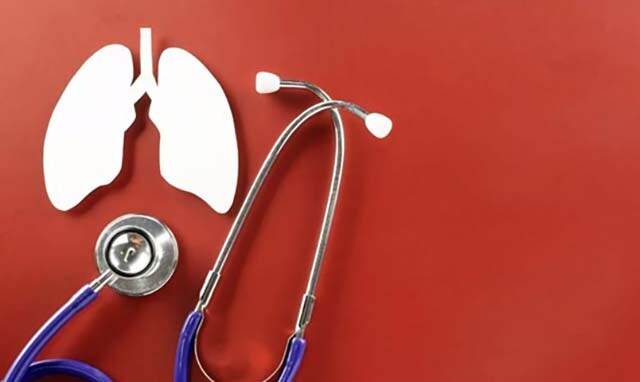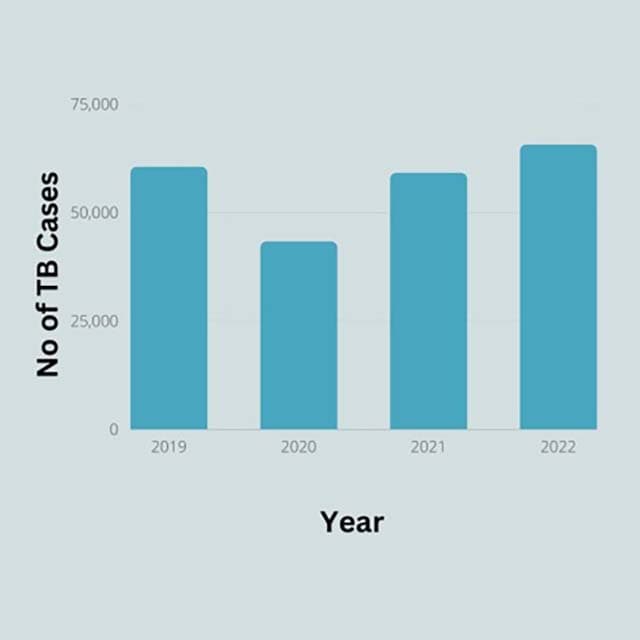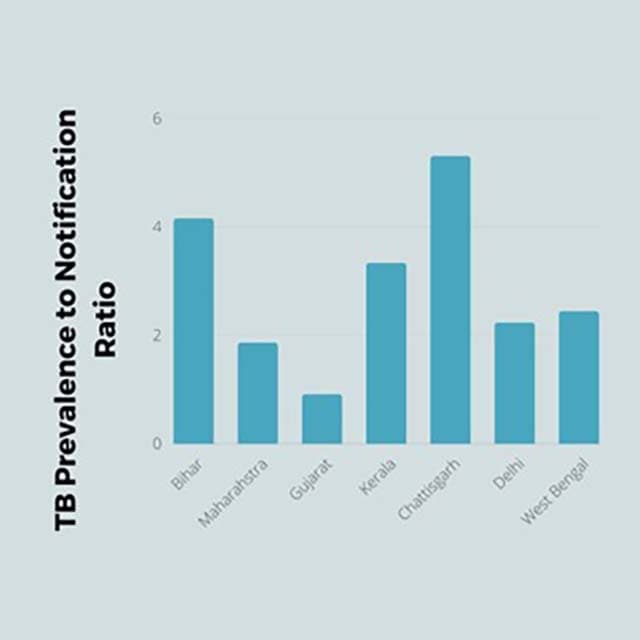TB trends in Mumbai: Past, present and future
TB trends in Mumbai: Past, present and future

On 22 September, 2023, the UN General Assembly will meet to renew a pledge to end TB by 2030. A recent report by the Lancet Commission, however, has highlighted how the world is not on course to achieving its TB-related targets. TB mortality rates have risen for the first time in two decades and India, Indonesia, and Nigeria contributed nearly 50 per cent to the total number of deaths.
In India, an ambitious yet timely TB Mukt Bharat Abhiyan is underway, which aims to end TB in India by 2025. The goal is significant as India contributes more than 25 per cent to the TB burden in the world.

In this context, tackling the TB menace in Mumbai is going to be central to achieving the government’s objective as Mumbai is widely hailed as one of the TB hotspots in India. According to an RTI report, it contributed nearly 30 per cent to India’s overall cases (2,145,422) in 2021.
While the number of TB cases dropped in 2020 in Mumbai, they rose to 65,617, in 2022, the highest ever in five years, according to data by the BMC’s public health department.
According to the India TB Report 2023, Mumbai’s case notification rate (the number of new cases reported per 1,00,000 of the population) stood at 183 in 2022, which was at the higher end of the spectrum. India’s overall case notification rate for 2022 was 172. India aims to achieve a case notification rate of only 77 by 2023.
Mumbai also contributes around 4,000 to 5,000 drug-resistant TB (DRTB) cases (58 per cent) in Maharashtra, according to BMC data from 2021. Drug-resistant TB occurs when Mycobacterium tuberculosis, the bacteria that causes TB, develops resistance to one or more of the drugs used to treat the disease.
DRTB: Types and treatment
Drug-resistant TB can develop due to several reasons, such as when doctors prescribe incorrect treatment, when patients do not complete the treatment course, or when poor-quality drugs are used.
DRTB can be of several types depending on the number of drugs the patient doesn’t respond to. The most severe form of DRTB is XDR-TB (Extensively Drug-resistant TB), in which patients don’t respond to many standard TB medicines.
Diagnosing DRTB may require specialized testing and expertise. Even its treatment requires many drugs to be administered for a long period of time. This is expensive and may cause severe side effects such as depression, hearing loss, and hepatitis.
TB treatment usually involves the administration of first-line and second-line drugs. First-line drugs are less expensive and toxic than second-line drugs, which are given when patients no longer respond to first-line drugs.
The drugs can be oral or injectable. However, WHO has been pushing for making the regimen all-oral so that patients don’t have to travel to hospitals to adhere to their treatment plan.
Patients need to take antibiotics for at least six months, but DRTB patients are usually prescribed a longer regimen.
To ensure that patients complete their treatment regimen, countries across the world follow DOT (Directly Observed Therapy), wherein a trained healthcare worker is assigned to each patient to make sure that they are taking drugs as prescribed. This is crucial since not sticking to the treatment plan may cause the patient to develop DRTB.
Why is Mumbai a TB hotspot?
Overcrowding, higher prevalence of slums, poverty, malnutrition and higher incidence of HIV are usually cited as the reasons behind the high TB burden in Mumbai.

In particular wards in Mumbai, such as Ghatkopar (N ward), Malad (P North), Dadar (G North) and Govandi (M East), TB cases went up by 147, 127, 83, and 38 per cent respectively in 2022. A health officer attributed the high numbers to overcrowding and poor ventilation in the slums in these areas.
Dharavi, the largest slum in Asia, reported around 265 DRTB patients in 2019, one of the highest concentrations in the world.
However, even when citizens are rehabilitated from slums, their susceptibility to TB may not decrease.
A study by IIT Bombay and Doctors for You looked at three resettlement buildings in M East. These buildings are usually closely packed together with hardly any sunlight. The study found that almost 1 in 10 households in the complexes with poor access to sunlight and ventilation had a person infected with TB.
Mumbai is also Maharashtra’s most high-risk district when it comes to HIV. In seven months in 2022-2023, it clocked 1,967 cases of a total of 8,500 cases in Maharashtra. Because of their weak immune system, a person living with HIV is more susceptible to contracting TB.
Is there more to the story?
Looking at only the notification numbers doesn’t give us the whole picture. One must also look at the prevalence-to-notification ratio. As per the National TB Prevalence Report 2019-2021, Maharashtra has a low ratio of 1.86, which means that for every 1 TB case that is detected, around 1.86 cases go undetected. Only Gujarat had a lower ratio than Maharashtra, which means that the government’s efforts at detecting TB cases are bearing fruit.

Several factors may contribute to TB cases going undetected or untreated. The stigma associated with TB may cause patients to not seek care or to not stick to their treatment regimen. A major challenge to TB alleviation in India is pretreatment loss to follow-up, which refers to patients not seeking registration for treatment after being diagnosed. The stigma comes from not only friends and family but from healthcare providers as well.
Poverty is another factor that not only increases vulnerability to the disease but also acts as a deterrent when it comes to seeking treatment. Although free healthcare is available to patients under the National Tuberculosis Elimination Programme, patients continue to incur direct as well as indirect costs, such as spending on hospitalization, travel, and loans.
Patients may also stop taking medication if their symptoms improve; failing to understand the disease and its implications can also cause patients to not stick to their treatment regimen. In India, for instance, where literacy rates among women are lower than that in men, there is less awareness about TB among women.
Efforts at tackling TB were boosted in Mumbai after totally drug-resistant strains were discovered in the city in 2012. The strains emerged due to the alleged maladministration of drugs by private healthcare providers.
Back then, the BMC took the decision to appoint civic health officials as TB officers for every ward. These officers were to oversee logistics and implementation details. The city also has the highest number of quick diagnostic facilities. Moreover, BMC was the first to start patients on newer drugs like bedaquiline and delamanid.
These are oral drugs that are prescribed for DRTB patients and are in line with the WHO’s recommendations for TB treatment.
The BMC has also proposed to set up DRTB centres in private hospitals to make access to drugs and treatment easier for DRTB patients.
Reversing the trend
The rise in cases post-COVID could be attributed to the decrease in screenings and detections during COVID-19.
What needs to be noted about the TB data released by the BMC is that Mumbai has been bucking the trend when it comes to the segregation of TB cases by gender. Globally, men form a higher percentage of TB patients than women. In Mumbai, however, for the last three years TB incidence has been higher in men than in women
In 2022, a total of 28,729 women were found to have TB as opposed to 27,454 men.
Health experts attribute this to the confinement during the pandemic, when women faced greater negligence in terms of healthcare than men. The pandemic has widely been regarded as having exacerbated pre-existing gender inequalities even in areas like healthcare.
What’s also noteworthy is that TB incidence among children in the city has been steadily increasing, going from 7 per cent in 2019 to 9 per cent in 2021.
What the future holds
The BMC is introducing a host of measures to be able to meet the 2025 target, from increasing the number of beds in hospitals to introducing genome sequencing in patients.
The Sewri TB Hospital, Asia’s biggest hospital for TB, recently reopened a pediatric ward for TB after four years in response to the increase in cases among children. The BMC is also working on opening a 10-bed ICU at the hospital.
Under the genome sequencing project, whole genome sequencing will be performed on multidrug-resistant TB patients to facilitate quick diagnosis and prescription. Genome sequencing is used to determine the genetic makeup of an organism and to understand variations, if any. At present, it may take weeks to determine which drugs would be most suitable for any patient.
The BMC has also enlisted the help of AI, by using software that detects TB in patients way before their symptoms first appear. It partnered with qure.ai, a digital health startup, to use AI-supported X-ray scans. Nearly 1,00,000 patients underwent these scans in 2021 and 2022 and around 35 per cent of TB diagnoses were detected using AI.
Since a significant proportion of TB cases are asymptomatic in the early days, using AI can go a long way toward facilitating early treatment.
Recently, the joint director of health services, Maharashtra, recommended TPT (Tuberculosis Preventive Treatment), under which people who come in close contact with MDR-TB (multidrug-resistant TB) patients are prescribed a drug regimen for 6 months.
Dr Zarir Udwadia, who first used the term “totally drug-resistant TB” in 2012, however, remains sceptical about the possible introduction of TPT. In a recently published article, Dr. Udwadia proposed that there was limited evidence to show the efficacy of TPT and the government would do well to wait for concrete evidence before going forward with it.
As for the question of Mumbai being TB-free by 2025, it remains to be seen whether this ambitious target can be fulfilled. As recently as August 2023, Mansi Bhagat, a 44-year-old suffering from TB, died because she could not get to an ICU in time. Her family, hailing from Prabahdevi, checked with at least five hospitals, including the Sewri TB hospital. None of them had ICU beds for MDR-TB patients.
Such incidents point out how major gaps still exist in the delivery and access of TB healthcare in Mumbai.
The authors are students of media at SCM Sophia Polytechnic, Mumbai. Views expressed in the above piece are personal and solely that of the author. They do not necessarily reflect Firstpost’s views.
Read all the Latest News, Trending News, Cricket News, Bollywood News,
India News and Entertainment News here. Follow us on Facebook, Twitter and Instagram.
What's Your Reaction?



























































